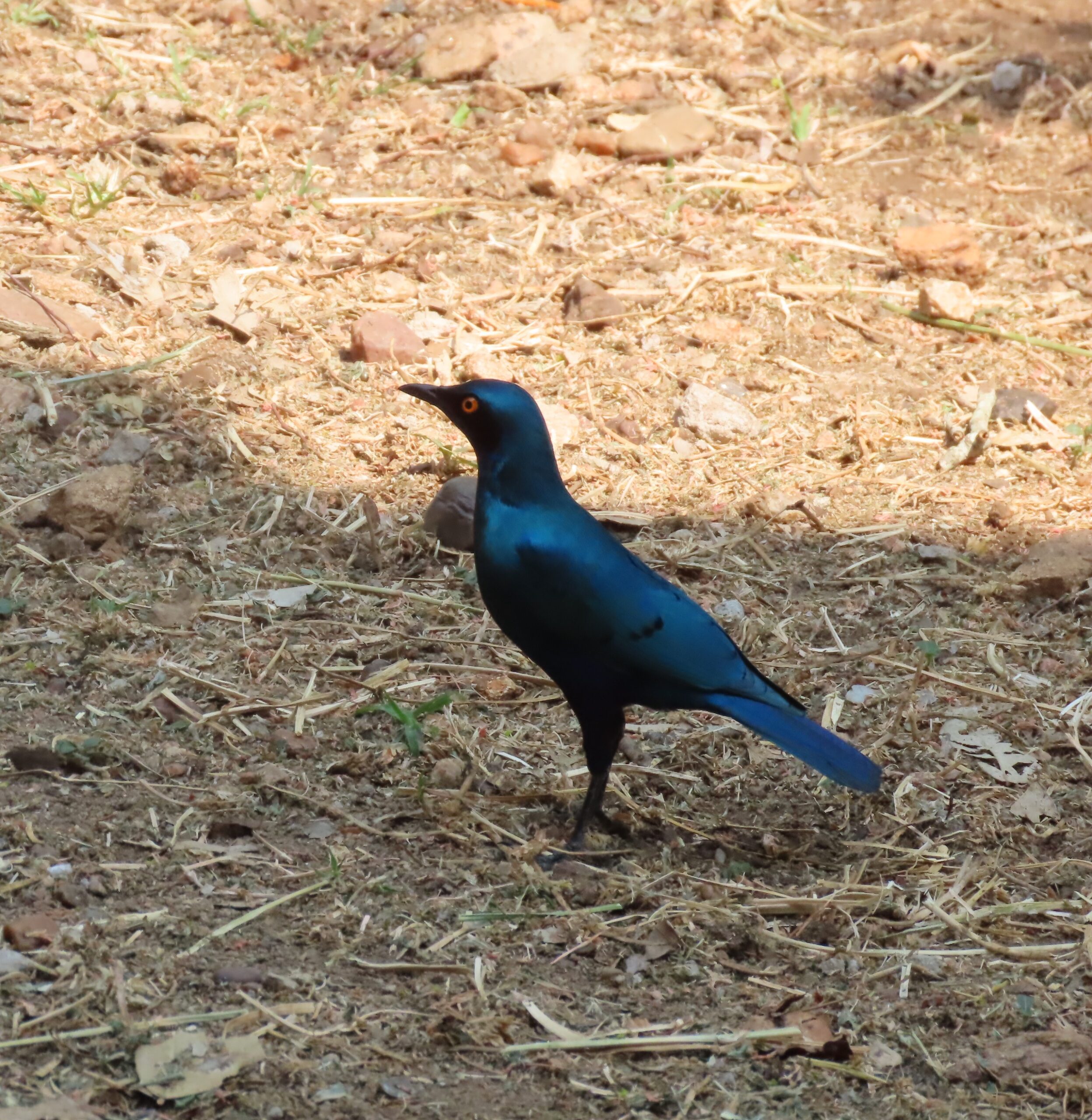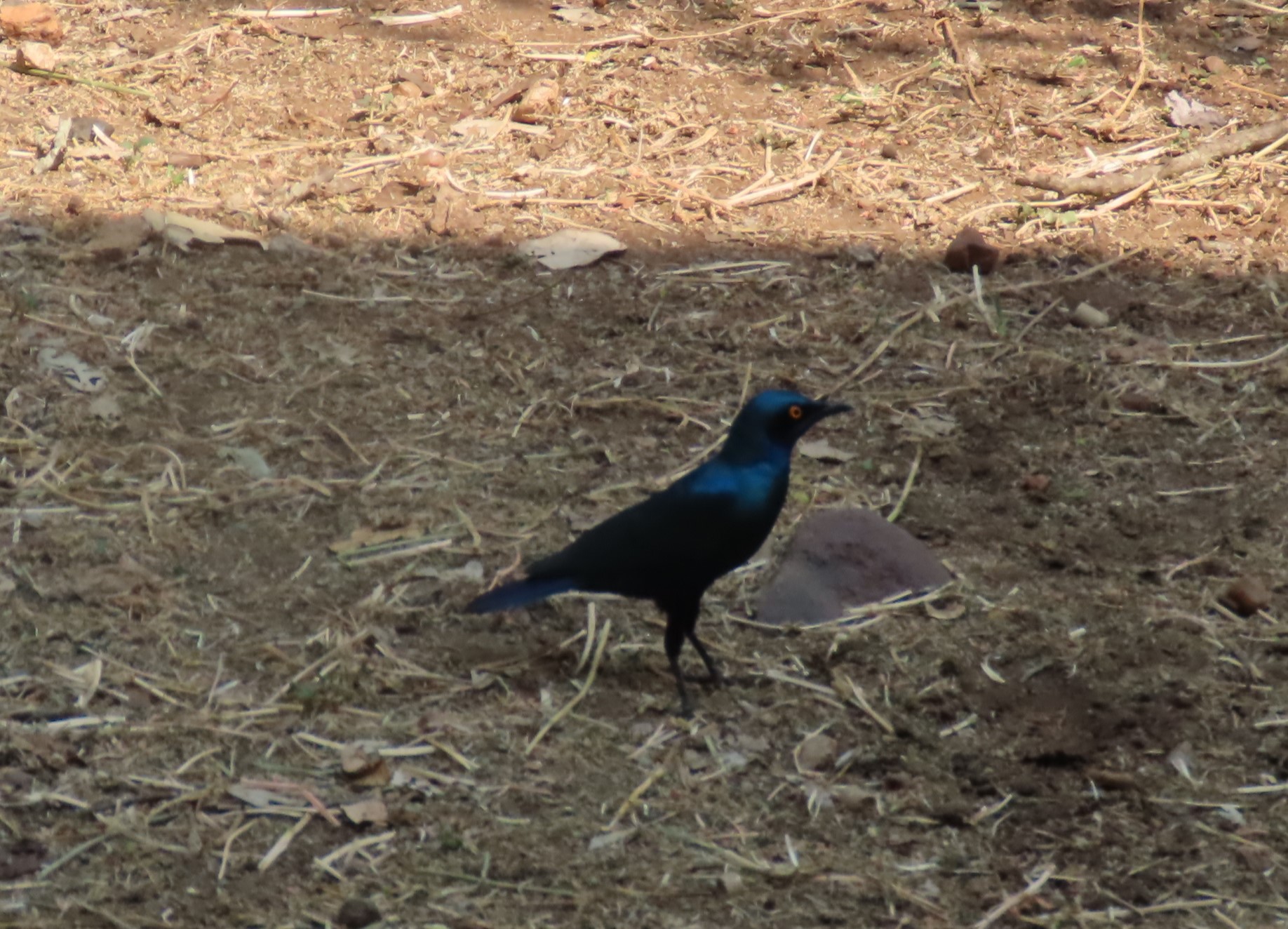
We have a bright blue iridescent starling that lives in our garden. Whenever another bird stops by, he goes after it to chase it away, except for other starlings, which are allowed to eat the seeds from the trolley between two trees and the bushbaby stand.
“Starlings are small to medium-sized passerine birds in the family Sturnidae. The name “Sturnidae” comes from the Latin word for starling, sturnus. Many Asian species, particularly the larger ones, are called mynas, and many African species are known as glossy starlings because of their iridescent plumage.”

“The Cape starling, red-shouldered glossy starling or Cape glossy starling (Lamprotornis nitens) is a species of starling in the family Sturnidae. It is found in Southern Africa, where it lives in woodlands, bushveld and in suburbs.”
Starlings are commonly seen birds, especially when they can scavenge for food. We often see them at the Mugg & Bean in Lower Sabie, walking on the dining tables, eating crumbs left by diners. Some are so brazen, they will alight while the diners are eating. Their diet consists of the following:
There are several other species of starlings, but we rarely see them or are able to determine which birds are the other species. No, we’re not birders, nor do we wish to become birders, although we enjoy seeing and taking photos of birds, especially those that are colorful and less commonly seen.
We named him Vega, which is listed as #5 in the top ten brightest stars in the night sky, as shown below from this site:
“The Top 10 Brightest Stars At Night
1. Sirius A (Alpha Canis Majoris)
Our number one star on the list. As mentioned, this star is part of the constellation Canis Major with an apparent magnitude of -1.5 and is 8.6 light-years away from Earth. You can spot this star from anywhere on our planet.
2. Canopus (Alpha Carinae)
This star is named after the mythological character Canopus who was a navigator for Menelaus, king of Sparta. It’s part of the constellation Carina and located at a magnitude of -0.72, 309. It is 310 light-years away from our Sun and can be seen from the Northern Hemisphere.
3. Rigil Kentaurus (Alpha Centauri)
At only 4.36 light-years from Earth, this star is part of the closest star system to our Solar System and consists of three stars with Rigil Kentaurus being the brightest. It is part of the constellation Centaurus with an apparent magnitude of -0.29. It is best spotted from the Southern Hemisphere.
4. Arcturus (Alpha Bootis)
The brightest star in the northern celestial hemisphere. This star is part of the constellation Bootes with an apparent magnitude of -0.04 and is about 37 light-years away from Earth. Its name originates from Greek and means ”Bear Watcher” or ”Guardian of the Bear” due it’s proximity to the Ursa Major (Big Bear). Fun fact, this star is actually a red giant.
5. Vega (Alpha Lyrae)
The name Vega comes from Arabic and literally means falling vulture. This is the most luminous star in the Lyra constellation with an apparent magnitude of +0.03, and it is relatively close, only 25.5 light-years away from Earth. Vega is visible from the Northern Hemisphere.
6. Capella (Alpha Aurigae)
Cappella or the Goat Star is the shiniest star in the Auriga constellation with an apparent magnitude of +0.08, 42 light-years away from Earth. This star is also best spotted from the Northern Hemisphere.
7. Rigel (Beta Orionis)
The brightest star in the constellation Orion, Rigel (from Arabic – ‘the left leg of the giant’) has an apparent magnitude of +0.18 and although it is 860 light-years away from Earth, it shines so bright because it’s a Blue giant star. It can be seen from the Southern Hemisphere.
8. Procyon (Alpha Canis Minoris)
Procyon, just like Sirius, is also part of a binary star system with its twin being a dwarf. It is located in the Canis Minor constellation with an apparent magnitude of +0.34 and at a distance of 11.46 light-years away from Earth. This star is visible from the Northern Hemisphere.
9. Achernar (Alpha Eridani)
Its name Achernar is derived from Arabic and means ”The End of the River”. This shiny celestial being is located in the Eridanus constellation with an apparent magnitude of +0.445 at a distance of 114 light-years away from Earth. You can spot it from the Southern Hemisphere.
10. Betelgeuse (Alpha Orionis)
And lastly, we have Betelgeuse which is the second most luminous star in the constellation Orion with an apparent magnitude of +0.42 and at a distance of 640 light-years away from Earth. The name Betelgeuse also derives from Arabic and means either ”the armpit of Orion” or ”the hand of Orion”. This star is visible from the Northern Hemisphere.”
Although #5’s description for Vega specifies a vulture, the starling is not in the vulture species. But, their behavior around food may cause one to consider them as somewhat of a vulture with their scavenging nature. They consume the following:
“Starlings mostly consume insects when available, especially beetles, grasshoppers, flies, and caterpillars, also spiders, snails, earthworms, and other invertebrates. Especially in fall and winter, eats a wide variety of berries, fruits, and seeds.”
How do we know Vega is a male? See this information below:
“The female starling looks less glossy and oily than its male counterpart but a key difference to tell the sexes apart is by the colour of their bills; blue for the males and pink for the females.”
Vega is a male, as shown in today’s photos.
Researching information about wildlife that stops in the garden is great fun. We hope our readers find these stories interesting as well.
Will Vega learn his name? I don’t know, but he just might as often as he’s here, and I say it to him. Frank, a francolin bird, learned his name at the last house. We shall see.
It’s about time for us to take off for Koomatipoort for today’s appointments and shopping. We’re heading to the pet shop to buy worms or crickets for Aggie, our colorful agama. We’ll be back tomorrow with Doc Theo’s assessment of my headache and facial pain. See you then!
Photo from one year ago today, October 14, 2021:

